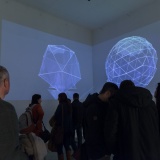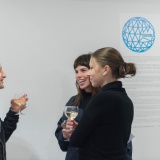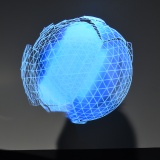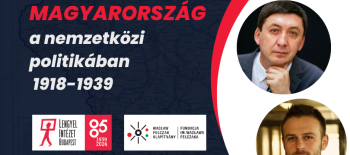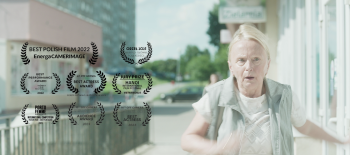TESSELL – interaktiv installáció 🗺
A kiállítást megnyitja: Szilágyi Róza Tekla, kurátor
Az installáció Buckminster Fuller monumentális, a montreali Expo 67-re készült kupolájára reflektál. Fuller a Földet egy, a kozmoszt átszelő homeostatként fogta fel, az emberiség túlélési esélyeit pedig attól tette függővé, hogy az megtartja-e belső egyensúlyát és képességét arra, hogy támogassa saját alkotóelemeit. „Tessel” azáltal fedezi fel Fuller geometriai felosztását, hogy a földgolyó távolból látható képét mutatja, amely folyamatosan dekonstruálódik.
A „Tessel” egy háromszögekre osztott gömbölyű forma (ld. tesselizáció), ami reagál a közönség mozdulataira a monitorozott helyen, olyan módon, hogy a mozdulatok dinamikáját átveszik a háromszögek. A „Tessel” interaktív hangsávval is rendelkezik, amely Rob Hordijk művész és designer ritka és relatíve új szintézis-technikájának, az úgynevezett „rungler” technikának felhasználásával készült.
A gömbszerű tér keretstruktúrájára rávetítik a valós idejű képet, reflektálva a közvetlen környezetre, és rejtélyes fényjelenségekkel vegyítve a videó képét. Időnként a Föld textúrája látszik, utalásként Fuller “űrhajó-Föld” koncepciójára.
A “Tessell”-lel okostelefonnal vagy tablettel is kapcsolatba lehet lépni. A linkre kattintva http://wrocenter.pl/tessell hozzáférést kaphatunk egy egyszerű felülethez, ami lehetővé teszi az installációval való kommunikációt, befolyásolhatjuk vele többek között a szilárd test hasadását és geometriáját, de egy algoritmus paramétereit is amelyek lehetővé teszik a virtuális tárgy felszínének deformálását, kihasználva a pixelek fényerejét.
Az installáció szimultán működik mind a WRO Art Centerben, Wroclawban, mind pedig a Koszyki Hall | Griffin Art Spaceben, Varsóban. Mindkét helyszín telematikusan kapcsolódik, tehát a mobileszközök interfészén keresztül küldött üzenetek hozzájárulnak az installációhoz mind Wroclawban, mind pedig Varsóban.
Megnyitó beszéd:
Now this is a place where so many things do meet. And by saying this I am not thinking of just people meeting at an opening. We are here – because of the artist himself, because we like installations or because we want to use every chance when there is a foreigner in town. Especially as we might be bored by the things we see all the time and so on. Or the most ironic option: just because we do not have anything else going on tonight.
But to keep things simple and serious: we are here at an exhibition opening, we see a work of art and we see digital techniques keeping it alive. While we are here there is an online application running via the web and there are people looking at the installation. Now this seemingly easy situation is getting more and more complicated, right? And we have not talked about all the information, history and human knowledge concentrated in this specific work of Pawel Janicki.
So in the first place there is history. We have Buckminster Fuller and his geodesic dome in Montreal. The famous architect created this building to be the American Pavilion at the World Fair, Expo 67. Now the former pavilion of the United States is called the Biosphere and it gives home to a museum dedicated to the environment. But why is this even important? Because this enclosed structure of steel and acrylic cells – among a lot other things – inspired Pawel Janicki to create what we see here. Tessell.
Fuller’s building is a hemispherical thin-shell structure based on a network of great circles on the surface of a hemisphere. This geometric structure brings in a new notion to our discussion. The tessellation. Without playing the oh-so-clever dictionary game it is important that we understand what tessellation means. Tessellation of a flat surface is the tiling of a plane using one or more geometric shapes with no overlaps and no gaps. So like an ancient mosaic. Or the surface of a disco ball.
But now enough with the lecture, the data and notion tsunami. Let’s just see. What is Tessell? It’s a sphere divided into triangles. Easy. We have a tile to hold on to. A periodic tiling which has a repetitive pattern. Our tiling here is not an average one. Because Tessell’s tiling – the triangles constructing our sphere here – reacts to movement of the audience. And our presence and dynamics are affecting the way the triangles move. We are shaping the artwork. In real time.
Being in an exhibition space as a visitor and having an immediate influence is a more common experience – thanks to the fast developing technique we use every day. But here our interactivity is just being in the space – yes, yes, of course it’s a simplified statement because we have to be in the monitored space-segment etcetera but I think you know what I mean. Even the lazy ones, who would never take part in an art project or would never give feedback in an exhibition space engage with this interactive installation. From visitors or observers we become part of the project. Of course we do not know anything about programming, most of us do not have deep knowledge in mathematics – those who have, please do not be angry for this generalization, you are the lucky ones and unfortunately I am not in your group. Yes. And most of us will never see the Earth from the space.
From the artwork’s perspective we are all equal in this exhibition space. And why did I bring the idea of looking at the Earth from space in the picture? Because there is a parallel democratization happening here. During the installation, at times we can see the texture of Earth. It seems a bit cheesy for the first glance, but we can see where we all live. Pawel Janicki does not close anyone out from the installation. Okay, maybe the astronauts who are in space now, but all the other human beings have a personal touch on this artwork – we in this gallery and even those who did not come.
Bringing in the picture of Earth is a reference to Fuller’s concept of “spaceship Earth”. And to peep out from our frog’s perspective. Yet there is an other important moment here: the artist originally is a creator – creator of the concept and the program that keeps the installation alive. He came down from the ivory tower to bring something what involves us too. Our interactivity is the participation. And now the artist is present. And his presence also comes hand in hand with his interactivity too.
So now, together with the artist we are part of an installation. An interactive installation which has a simple interface online where we can communicate with the artwork. An installation what is parallel present at three different places on Earth. How cool, isn’t it?






